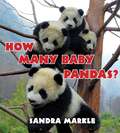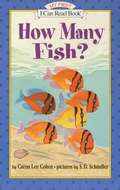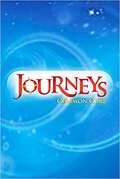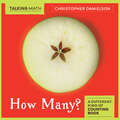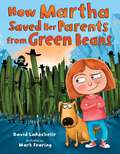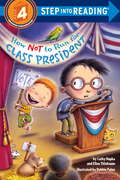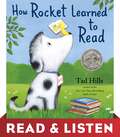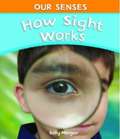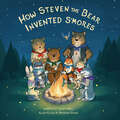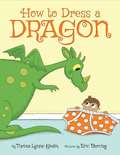- Table View
- List View
How Long Is a Month? (The\calendar Ser.)
by Claire ClarkA lot happens in a month! As the moon makes one trip around Earth, plants grow and you do too. Find out more in How Long Is a Month?
How Many Baby Pandas?
by Sandra MarkleBaby pandas abound as readers learn how they live and grow. Science expert Sandra Markle bumps up the cuteness factor in this adorable photo essay featuring the eight panda pairs that were born during a baby boom at China's Wolong Giant Panda Breeding and Research Center in 2005. Basic counting skills combine with panda facts to introduce readers to numbers and these cuddly cubs, from the moment they were born to the time they started climbing trees. Tracked as they play and grow in captivity, until they are strong enough to be released into the wild, these baby pandas will steal any reader's heart, whether it's one at a time or sixteen at once!
How Many Dolphins In a Pod?: Counting By 10's (Nature Numbers)
by Ruth MusgraveIn Nature Numbers, math is beautiful, recognizable, and all around us! Highly engaging pictures of animals and nature scenes, along with cool chalk illustrations, are used to introduce basic math concepts and encourage kids to see a world of numbers all around them.K-2 math concepts include power of 10. This book encourages kids to learn about multiples of 10 as schools of fish swim by and coral polyps build reefs, all with amazing nature pictures and chalk illustrations!
How Many Fish? (I Can Read! #My First Shared Reading)
by Caron Lee CohenA story of six fish and six feet interact underneath the water. When one fish gets lost under a bucket, the feet unknowingly saves the fish.
How Many Penguins?: Counting Animals 0-100 (Nature Numbers)
by Jill EsbaumIn Nature Numbers, math is beautiful, recognizable, and all around us! Highly engaging pictures of animals and nature scenes, along with cool chalk illustrations, are used to introduce basic math concepts and encourage kids to see a world of numbers all around them.K-2 math concepts include counting 1-100. This book encourages kids to count groups of 10 animals with amazing nature pictures and chalk illustrations!
How Many Stars in the Sky? (Journeys)
by Lenny Hort James E. RansomeNIMAC-sourced textbook <P><P>Lexile Measure: AD500L
How Many? (Talking Math Ser.)
by Christopher DanielsonTalking math with your child is fun and easy with this better approach to counting!Written by a math educator, this innovative book encourages critical thinking and sparks memorable mathematical conversations. You and your child decide what to count on each page. You have many choices, and the longer you look, the more possibilities you'll notice. There are no wrong answers in this book. As long as you're talking about what you see, think, and wonder, you're talking math!
How Martha Saved Her Parents from Green Beans
by David LaRochelleMartha HATES green beans. When some mean, green bandits stroll into town, anyone who ever said "Eat your green beans" is in big trouble. But when the beans kidnap Martha's parents, Martha is forced to take action. She can think of only one way to stop the villainous veggies from taking over her town, and it&’s not pretty...or tasty. Featuring absurdly funny text and illustrations with attitude, this is a hilarious read for everyone – even the pickiest of eaters.
How Mountains Are Made (Let's-Read-and-Find-Out Science 2)
by Kathleen Weidner ZoehfeldRead and find out about how mountains are made in this colorfully illustrated nonfiction picture book.A mountain might be thousands of feet high, but it can still grow taller or shorter each year. This classic picture book explores how mountains are made—including how Mount Everest grew from a flat plain under an ocean to become 29,028 feet tall.How Mountains Are Made features simple activities and fascinating cross-sections of the earth’s moving crust that clearly explain plate tectonics. Both text and artwork were vetted for accuracy by an expert in the field.This is a clear and appealing science book for early elementary age kids, both at home and in the classroom. It's a Level 2 Let's-Read-and-Find-Out, which means the book explores more challenging concepts for children in the primary grades. The 100+ titles in this leading nonfiction series are:hands-on and visualacclaimed and trustedgreat for classroomsTop 10 reasons to love LRFOs:Entertain and educate at the same timeHave appealing, child-centered topicsDevelopmentally appropriate for emerging readersFocused; answering questions instead of using survey approachEmploy engaging picture book quality illustrationsUse simple charts and graphics to improve visual literacy skillsFeature hands-on activities to engage young scientistsMeet national science education standardsWritten/illustrated by award-winning authors/illustrators & vetted by an expert in the fieldOver 130 titles in print, meeting a wide range of kids' scientific interestsBooks in this series support the Common Core Learning Standards, Next Generation Science Standards, and the Science, Technology, Engineering, and Math (STEM) standards. Let's-Read-and-Find-Out is the winner of the American Association for the Advancement of Science/Subaru Science Books & Films Prize for Outstanding Science Series.
How Not to Run for Class President
by Debbie Palen Ellen Vandenberg Catherine A. HapkaLooking for a fun, light introduction to the campaign process? Join the brothers from the How Not to . . . series as they navigate a class election! Third grader Will couldn't care less about boring school politics. But when his friend Chelsea proposes a Reading Buddy program that would require Will to hang out with the kindergartners (and therefore his little brother, Steve), he makes an impulsive decision to run against her! Supportive brother that he is, Steve takes full responsibility for managing his brother's campaign . . . and things quickly spiral out of control. This fun reader gently teaches what it means to be a responsible politician, and even gets some election basics into the mix. A hilarious tool to kick off classroom units on elections! Step 4 Readers use challenging vocabulary and short paragraphs to tell exciting stories. These books are for newly independent readers who read simple sentences with confidence.From the Trade Paperback edition.
How People Learned to Fly
by Fran HodgkinsIn this book you find out about the many obstacles that have been overcome so planes and people can soar through the sky. <P><P>[This text is listed as an example that meets Common Core Standards in English language arts for K-1 at http://www.corestandards.org.]
How Plants Grow (Time For Kids®: Informational Text)
by Dona Herweck RiceBeginning readers explore the steps to make plants grow! Readers will learn about various parts of the plant including seeds, roots, and leaves in this engaging nonfiction title. Featuring vivid, clear photos and simple, informational text, even the most reluctant reader will be captivated!
How Rocket Learned to Read (Rocket)
by Tad HillsThis sweet picture book starring an irresistible dog named Rocket and his teacher, a little yellow bird, is perfect for back-to-school! Follow along as Rocket masters the alphabet, sounds out words, and finally . . . learns to read all on his own. With a story that makes reading fun-and will even help listeners learn to read-this book is ideal for kindergarten classrooms and story hour or as a gift for that beginning reader. Fresh, charming art by Tad Hills, theNew York Timesbestselling author/illu...
How Rocket Learned to Read: Read & Listen Edition (Rocket)
by Tad HillsLearn to read with this Read & Listen edition of the New York Times bestselling picture book, starring an irresistible dog named Rocket and his teacher, a little yellow bird. Follow along as Rocket masters the alphabet, sounds out words, and finally . . . learns to read all on his own!With a story that makes reading fun—and will even help listeners learn to read—this book is ideal for kindergarten classrooms and story hour or as a gift for that beginning reader. Fresh, charming art by Tad Hills, the New York Times bestselling author-illustrator of Duck & Goose, will make this a favorite.This ebook includes Read & Listen audio narration.
How Sight Works (Our Senses)
by Sally MorganThis book introduces the sense of sight and how it helps us function in everyday life.
How Slow Is a Sloth?: Measure the Rainforest (Nature Numbers)
by Jill EsbaumIn Nature Numbers, math is beautiful, recognizable, and all around us! Highly engaging pictures of animals and nature scenes, along with cool chalk illustrations, are used to introduce basic math concepts and encourage kids to see a world of numbers all around them.K-2 math concepts include measuring. This book explores measuring elements of the rainforest with amazing nature pictures and chalk illustrations!
How Smell Works (Our Senses)
by Sally MorganWhy do some things smell good and other things smell bad? This book explains where our sense of smell comes from and how it helps us function in everyday life. A lively, straightforward narrative presents scientific concepts for young readers and an activity is included enhance the learning experience.
How Steven the Bear Invented S'mores (Steven the Bear)
by Scott HallHow Steven the Bear Invented S’mores is a read aloud picture book with fun life lessons and colorful illustrations. Steven the Bear and his friends are excited to go on their very first camping adventure. After being sure to pack and prepare well, the Bear Bunch heads out to find the perfect campsite. They set up camp and spend their day hiking, bird watching, and finding animals. After a day full of fun, Steven and the Bear Bunch sit down to toast marshmallows. That’s when Steven has a brilliant idea…? Join Steven the Bear and his friends in this first of many adventures!
How To Dress A Dragon
by Thelma Lynne GodinA small child helps his reluctant, toddler like dragon get dressed.
How To Dress a Dragon
by Thelma Lynne Godin Eric BarclayIf you have to dress a dragon, you must be prepared to catch him as he flies by. Also, beware of ticklish toes, shirts with buttons, and hats that do not fit neatly between his horns! In this charming, second-person narrative, our little boy hero imparts his infinite knowledge of how to dress a dragon, a task that isn't quite as easy as it may seem. With helpful hints like, You may have to tickle-tackle him to the floor and give him belly kisses, and warnings like, Dragons do not like shirts. But they do like capes! this story is not only delightfully entertaining, but extremely endearing. Author Thelma Lynne Godin and illustrator Eric Barclay come together perfectly to bring this fantasy to life!
How To Dress a Dragon
by Thelma Lynne GodinThis fantastical story about a little boy trying to dress his pet dragon is heartwarming, imaginative, and full of laughs! If you have to dress a dragon, you must be prepared to catch him as he flies by. Also, beware of ticklish toes, shirts with buttons, and hats that do not fit neatly between his horns! In this charming, second-person narrative, our little boy hero imparts his infinite knowledge of how to dress a dragon, a task that isn't quite as easy as it may seem. With helpful hints like, You may have to tickle-tackle him to the floor and give him belly kisses, and warnings like, Dragons do not like shirts. But they do like capes ! this story is not only delightfully entertaining, but extremely endearing. Author Thelma Lynne Godin and illustrator Eric Barclay come together perfectly to bring this fantasy to life!
How To Read A French Fry and Other Stories of Intriguing Kitchen Science: And Other Stories of Intriguing Kitchen Science
by Russ ParsonsWhy can you stick your hand into a 450-degree oven but not into 212-degree boiling water without burning it? Why does fish taste different from meat? Why do you cook pork differently from beef? Why should you always start cooking dried beans in cold water, not warm? Why should you never cook a Vidalia onion? What's the only kind of marinade that&’s really an effective tenderizer? Why is strawberry-rhubarb a good combination, scientifically speaking? And why don&’t potatoes fried in fresh oil ever brown completely, no matter how long they're cooked? &“Cooking is full of questions that science can help you answer, questions that can make you a better cook,&” writes the award-winning Los Angeles Times food editor, Russ Parsons. In this entertaining book packed with fascinating tidbits, Parsons explores the science behind such basic cooking methods as chopping, mixing, frying, roasting, boiling, and baking. You&’ll learn why soaking beans can&’t offset their gaseous effects, why green vegetables shouldn&’t be cooked under a lid for long, which fruits you can buy unripe and which you should buy fully ripened, which thickener to choose for your turkey gravy, and which piecrust is foolproof for a beginner. Along the way, Parsons slips in hundreds of cooking tips, provocative trivia, and touches of wit that make his scientific explanations go down smoothly. He also includes more than a hundred recipes that deliciously exemplify the principles he describes, from Tuscan Potato Chips and Crisp-Skinned Salmon on Creamy Leeks and Cabbage to Chocolate Pots de Creme and Ultimate Strawberry Shortcake.
How To Two
by David SomanFrom the co-creator of the New York Times bestselling Ladybug Girl series comes a joyful counting book about inclusivity, play, and the thrill of making new friends--from one to ten and back again.A quiet day at the playground turns into a boisterous park-wide adventure as one boy on the slide becomes two kids on the see-saw, then three jumping rope. Before long, ten new friends are playing like they've known one another forever.With its deceptively simple text and a rich visual narrative, How to Two is a playful counting and reverse-counting concept book as well as an exuberant celebration of inclusive play, friendship, and community."No two ways about it--this one is a delight." --Kirkus"A joyous celebration of play...Seamless...Diverse." --The Horn Book (starred review)"Inviting and welcoming." --BCCB (starred review)"Dynamic." --Booklist"Exciting." --Publishers Weekly

